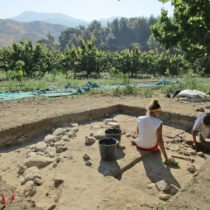There is scarcity of information coming from the ancient period of Frangokastello. Pottery from the Minoan Era and building remnants from the Hellenistic and Roman Period have been located in the major area around the castle. Apparently, an early Christian settlement prospered here as evidenced by the two remaining basilicas, that of St. Nikitas and Astratigos. In 1340, the Venetian feudal lords of Chania sought license from the government for the erection of a castle that would provide shelter from the local rebels and the pirates. The license was issued in 1371 and the construction works were completed by 1374. The adjacent abandoned settlement supplied the building material for the erection of the castle. Due to the increasing Turkish threat the castle was additionally fortified during the years 1793-1797. In the Greek Revolution of 1821 the castle plays a minor role and is abandoned thereafter. Inhabitants of the area connect a metaphysical phenomenon; that of the appearance of warrior-like shadows at daybreak in early May, with the part palyed by Frangocastello in the Revolution. Frangokastello today is not different from depictions of it from the period of Venetian rule, although it has undergone many reconstructions. It is rectangular in plan with towers on the corners; the SW still standing intact. The coat of arms of the Qerini family decorates the south, while another coat of arms showing the lion of Venice once existed above the entrance to the castle. In older representations of the castle, the church of St. Mark is shown inside the fortress. However, it is a false indication, since the church stood approximately ten meters outside the south side. The picturesque area of Frangokastello has, unfortunately, been ruined by the irrational modern buildings of reinforced concrete. The archaeological service in its effort to control building activities and to protect the beautiful landscape provokes the hostility of the inhabitants who try to destroy and extinguish what they regard as the cause of the strict limitations, that is the remnants of the monument.
Frangokastello
31 Jul 2012
by Archaeology Newsroom
- A
- A
- A

